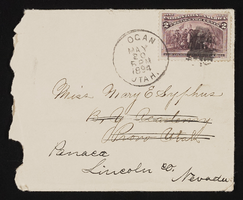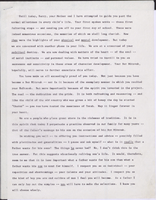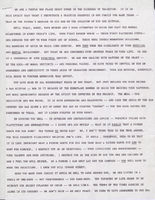Search the Special Collections and Archives Portal
Search Results
Southern Nevada Memorial Hospital Records
Identifier
Abstract
The Southern Nevada Memorial Hospital Records (1955-1956) consist of Southern Nevada Memorial Hospital (SNMH) records including minutes of Board of Trustees meetings, Grand Jury accusations against the Board regarding the poor operation of the hospital, the Board's responses, and newspaper clippings from the Las Vegas Review-Journal regarding this controversy.
Archival Collection
Felicia F. Campbell Collection on the Governor's Commission on Status of People Records
Identifier
Abstract
The Felicia F. Campbell Collection on the Governor’s Commission on Status of People Records (1970-1977) is comprised primarily of meeting minutes, agendas, reports, and memorandums from the Nevada Commission. The collection also contains women’s rights commission handbooks from various states and correspondence and newspaper clippings pertaining to Campbell's professional life.
Archival Collection
Mildred J. Heyer Photograph Collection
Identifier
Abstract
The Mildred J. Heyer Photograph Collection consists of four black-and-white photographic prints and negatives from approximately 1905 to 1940. The photographs depict early Las Vegas, Nevada street scenes, an irrigation pump, and Liberty’s Last Stand, a prominent saloon in Nevada during Prohibition.
Archival Collection
George Mortimer Photograph Album of Searchlight, Nevada
Identifier
Abstract
The George Mortimer Photograph Album of Searchlight, Nevada dates between approximately 1900 and 1910, and contains black-and-white photographic prints illustrating various scenes and individuals in Searchlight, Nevada. Some images are captioned with initials or brief names.
Archival Collection

Stephen Round oral history interview: transcript
Date
Archival Collection
Description
Oral history interview with Stephen Round conducted by Claytee D. White on October 25, 2017 for the Remembering 1 October Oral History Project. In this interview, Stephen A. Round, a career military contractor, describes his experiences during the 2017 mass shooting in Las Vegas, Nevada. Round mentions moving to Las Vegas in 2013 and in later years staying at the Aria on the evening of October 1. He describes the chaos of the shooting and the 12-hour-plus lockdown at the Aria hotel and casino. The day after the shooting, Round built a memorial around the shooting site and protected it. Once the memorabilia of that first site was taken to the Clark County Museum, he moved to protect the second memorial at the "Welcome to Las Vegas" sign where crosses devoted to the victims had been placed. Along with his preservation of the memorials, Round describes his preparation of a book that was signed by many who visited the sites. Round explains that he was able to see some of the best and worst of humanity during those days of watching and caring for the memorial sites as well as helping any victims, families of the victims, and sympathizers of the Las Vegas 2017 shooting.
Text

Letter and envelope from John M. Bunker, Logan, Utah to Mary Etta Syphus, Provo, Utah
Date
Archival Collection
Description
From the Syphus-Bunker Papers (MS-00169). The folder contains an original handwritten letter, an envelope, a typed transcription of the same letter, and a copy of original letter attached.
Text

Transcript of interview with Charles Nur Fernald by Claytee D. White, May 31, 2014
Date
Archival Collection
Description
Text
Fallman Family Papers
Identifier
Abstract
The Fallman Family Papers (approximately 1950-2005) consist of correspondence, newspaper clippings, photographic prints and slides, scrapbooks, and pamphlets from James and Ima Fallman and their daughter, Janice. The correspondence primarily relates to James and Ima Fallman and chronicles Ima's involvement with the Francisco Garces chapter of the Daughters of the American Revolution (DAR), James's work as a bartender in Las Vegas, Nevada, and awards he received during World War II. The newspaper clippings mention either James Fallman or his daughter, Janice, and her involvement with the Las Vegas High School Rhythmettes dance team. The majority of materials from Janice describe her school days at Las Vegas High School and events participated in as a child and young adult.
Archival Collection


